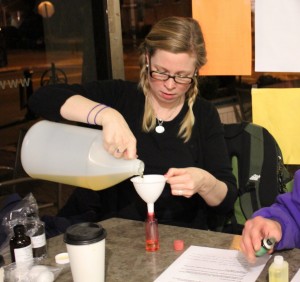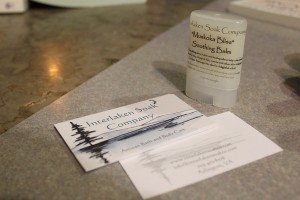Prior to having snow cancel 2.5 days off of school (and all local evening activities) the week before last, I got to attend a wonderful Moms Night Out with my chapter of Holistic Moms Network, starring special guest beauty mixologist
Amy Fromm of Interlaken Soak Company. I met Amy back in the spring when my friend Kim and I stopped by the Columbia Pike farmer’s market on our way to prenatal yoga. I’ve been enjoying the delicious foot scrub I bought from her that rainy day and am so glad she agreed to come speaK to HMN. (And that I actually made it out of the house that night!)
Amy gave us the low-down on ingredients in beauty products and shared a whole bunch of tips on making your own. I’m so glad the weather waited until after this event to bring on the snow.
The following is adapted from my article on my Washington Times Communities column.
If you can’t pronounce it, don’t use it” cautioned Amy, who reminded the group that the skin is the body’s largest organ. “Whatever you put on your body, you’re putting into your body.”
Amy’s presentation began with tips about things to avoid. Petroleum jelly is just that – refined oil – and it creates a barrier that doesn’t allow the skin to breathe. “Fragrance” listed as an ingredient can often indicate phthalates, chemicals that are usually used as a solvent or to make plastics more flexible. According to the Environmental Working Group, phthalates are endocrine disruptors. Many of the discussion attendees said they already look for products that specifically say that are phthalate-free, often in the aisles of MOM’s Organic Market or Whole Foods.
Other ingredients to avoid include parabens, endocrine disruptors that have been linked to cancer and sodium lauryl sulfate, which, Amy explained, is a surfactant that thins out molecules to reduce their surface tension and make the product spread further. This allows other ingredients to be more absorbed by the body.
Since there is no governing body to regulate the word “natural” on products, it’s important to know the companies you buy from, Amy said. Her products are available at the Proper Topper throughout DC and in Falls Church at Stifel & Capra (in addition to the farmer’s market on Saturdays).
 Amy kindly cut into her own customer base by sharing resources with moms wishing to learn how to make our own products. In addition to supplying them with a custom-made body oil, Amy showed the group some of the many books she has consulted since starting her business in 2009. While Fromm poured sweet almond oil into the moms’ recycled travel-size containers, the women pored over titles such as A Consumer’s Dictionary of Cosmetic Ingredients, Essential Aromatherapy, Natural Beauty at Home and Gorgeously Green. Fromm is also planning to launch her own line of mother and baby products later this year, for which Organic Baby Care Recipes will surely come in handy.
Amy kindly cut into her own customer base by sharing resources with moms wishing to learn how to make our own products. In addition to supplying them with a custom-made body oil, Amy showed the group some of the many books she has consulted since starting her business in 2009. While Fromm poured sweet almond oil into the moms’ recycled travel-size containers, the women pored over titles such as A Consumer’s Dictionary of Cosmetic Ingredients, Essential Aromatherapy, Natural Beauty at Home and Gorgeously Green. Fromm is also planning to launch her own line of mother and baby products later this year, for which Organic Baby Care Recipes will surely come in handy.
The group discussed a wide array of healthful ingredients to choose from when making your own products. Some favorites included apricot kernel oil for massage and avocado oil for a thicker barrier cream. Sunflower oil, Amy said, is closest to our own human sebum. Other ingredients to consider for lotions and balms include cocoa butter and shea butter, beeswax and honey. Fromm is a big fan of calendula and suggests planting some flowers in order to distill your own oil.
Flours such as arrowroot and tapioca can be used for dusting powders instead of talc, which as been linked to asbestos and ovarian cancer. Epsom salts not only break down lactic acid, which is why athletes often use them in the tub, but they can also act as a mood balancer because of their mineral properties. Soaking in an Epsom salt bath can also lower blood pressure, Amy noted.
One woman shared that she already used baking soda (applied by a blush brush) as an effective deodorant but was surprised to know that the powder can help relieve rashes when applied in a paste or used in a bath. Bath water should never be too hot, Amy noted, or it will try the skin, and 15-20 minutes is plenty of time, so busy moms need not lock themselves away for a whole hour to reap the benefits.
With the exception of lavender, essential oils should always be applied in a carrier oil rather than dropped into water or applied “neat,” directly from the bottle, where their strength has the potential to burn skin. Amy also reminded us that essential oils have physical as well as emotional properties and should not be used indiscriminately. Putting peppermint oil in a bath can actually lower a person’s body temperature, so it’s better used in an oil on tired feet. Consulting a manual for contraindications, especially during pregnancy, is a good idea.
After nearly two hours, our group broke up smelling and feeling divine, with new recipes to try at home and a keener eye for how to read labels at the store.


Leave a Reply
You must be logged in to post a comment.